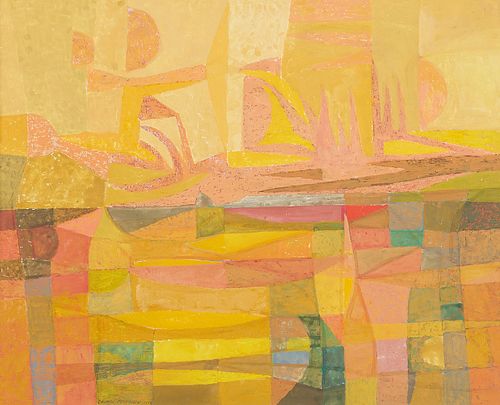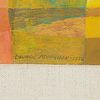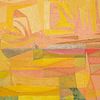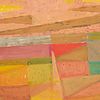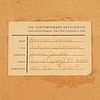竞拍增价
| 价格 | 竞拍增价 |
|---|---|
| $0 | $25 |
| $300 | $50 |
| $1,000 | $100 |
| $3,000 | $200 |
| $5,000 | $500 |
| $10,000 | $1,000 |
| $20,000 | $2,000 |
| $50,000 | $5,000 |
| $100,000 | $10,000 |
| $500,000 | $25,000 |
| $1,000,000 | $50,000 |
| $10,000,000 | $100,000 |
Lot Essay:
Regarded as the founding figure of Native American modernism and among the top American abstract expressionist painters is George Morrison. Also highly regarded as a master collage artist, he assembled large collages of found driftwood and woodcut in framed, puzzle-like forms. In the 1940s, he was formally trained at the Minneapolis College of Art and in the 1950s at the Art Students League in New York before receiving a Fulbright to study in France. Taking his place as part of the modern art movement in New York in the 1950s after World War II, he was friends with Jackson Pollock and Willem de Kooning, regularly exhibiting with de Kooning, Philip Guston, Hans Hofmann, and Franz Kline. Morrison helped bring the New York Modern Art movement to Minnesota, where he was based and worked with pure form via Abstract Expressionism. Later in his career, in the mid-1970s, Morrison shifted to a new theme and started to really explore his heritage when he and his family built a home with an art studio on the Grand Portage Indian Reservation on Lake Superior, naming it Red Rock.
Rather than portraying an overt depiction of identity, Morrison was in the process of exploring his identity so he looked to nature, stating “in this search for my own identity, I seek the power of the rock, the magic of the water, the religion of the tree, the color of the wind and the enigma of the horizon.†Translating nature into paintings was Morrison’s way to navigate learning and absorption, and in turn produce self-expression. His token theme was the horizon, taking on dynamic form as colors or shapes in the eternal motion of nature. His inspiration was provided by Lake Superior, observing and documenting the temporary sight of the revered sky meeting landscape that he beheld in the moment.
Although his body of work on horizons didn’t make overt reference to his Ojibwe roots, it instead offers a respectful nod to Ojibwe culture. In creating this body of work, he ushered in a change to expectations imposed on Native artists, offering himself as a catalyst towards breaking the barrier that relegated Native American artists to feel a pressure to center upon subjects that were overtly self-reflective and rooted in identity politics. This effort boosted Moorison into a champion founder of Native American modernism. He taught at colleges like the Rhode Island School of Design and later taught American Indian studies and art at the University of Minnesota. A spotlight in the Minnesota art scene, Morrison’s success stemmed from his eventual grounding in nature and Anishinaabe culture and using that to offer his take on spiritual landscape paintings.
Morrison is also well-known for his woodcut collages, large in scale with a look that was either all natural in driftwood or all polished with sanded, sculpted wooden pieces. The collages display horizontally, again with an intent of capturing the shifting movements of the horizon. He altered the medium once more by creating rubbings of his wood collages, further emphasizing patterns created by momentary sights of the horizon and which served to re-invigorate the works with the rawness witnessed in the natural environment.
His artworks are spotted today in the collections of the Heard Museum, Philadelphia Museum of Art, and Whitney Museum of American Art, US National Gallery of Art, Minneapolis Institute of Art, and the Walker Art Center. In 1997 he was honored in a ceremony at the White House when his work was included in the Twentieth Century American Sculpture at The White House: Honoring Native Americans exhibition. In 1999 Morrison was honored as inaugural Master Artist in the Eiteljorg Museum of American Indians and Western Art, Indianapolis.
Sight; height: 18 1/2 in x width: 23 1/4 in. Framed; height: 26 1/2 in x width: 31 in.
状态
Available payment options

Payment & Shipping PAYMENT Revere Auctions accepts wire transfers, checks (personal or business check in US dollars certified by a US bank, a cashier’s/banker’s check drawn on a US bank or US money order), cash (US currency not to exceed $10,000 in a single or multiple related payments). Visa, Discover, American Express or MasterCard may be used and are subject to a 3.0% convenience fee and are limited to purchases of $5,000.00 (total). Credit Card payments for jewelry and gold are NOT accepted. The purchaser’s obligation to pay immediately the full purchase price is absolute and unconditional and is not subject to any defenses, setoffs or counterclaims of any kind whatsoever. Revere Auctions is not obligated to release a lot to the purchaser until title to the lot has passed. The purchaser agrees to pay Revere Auctions handling charge of $30 for any check dishonored by the drawee. SHIPPING Revere Auctions does NOT offer in-house shipping. As a convenience to the Buyer, Revere Auctions will make a referral for packing and shipping. This is at the request, expense, and risk of the Buyer, and Revere Auctions assumes no responsibility for the items or the timing of delivery. Insurance for in transit items is the responsibility of the buyer. The buyer must reach out to a shipping company to arrange shipping. The buyer must fill out and return the Shipping Release Form to info@revereauctions.com in order for their items to be released. This is to ensure that the won item(s) are given to the proper shipping company and reach their final destination safely. This form can be found here: https://www.revereauctions.com/wp-content/uploads/2022/07/ShippingRelease_Fillable2022.pdf Here is a list of our preferred shippers: UPS Store #2105 Contact: Ryan Wilson Email: store2105@theupsstore.com Phone: 651-642-5972 UPS Store #2158 Contact: Randy Email: store2158@theupsstore.com phone: 651-635-0636 UPS Store #5396 Contact: Seth Email: store5396@theupsstore.com Phone: 612-332-4117 Museum Services Inc For shipping estimate please complete the following link: http://museumservices.org/revere For our full list of shipping referrals and information please see our shipping information page with more details: https://www.revereauctions.com/shipping-information/
问询

请输入您的电子邮箱登录
输入电子邮件以创建一个帐户以开始出价。
输入电子邮件以创建一个帐户以开始出价。

